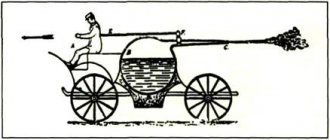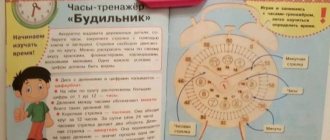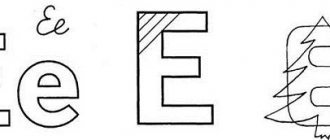Summary of a mathematics lesson in 5th grade. Topic: Numeric and alphabetic expressions
Lesson on the topic: Numerical and letter expressions, grade 5
Objectives: • educational: to contribute to the formation of students' knowledge about numerical and letter expressions, the meanings of expressions, the rules for obtaining a letter expression based on a number;
promote the formation of skills in composing and solving expressions; • developing: to develop mental activity, intuition, motivation for the practical significance of this topic, the culture of mathematical speech; • educational: continue to develop students’ control and self-control skills, communication skills, culture of mental work, aesthetic skills of writing on the board and in notebooks, perseverance. Lesson progress:
1. Organizational moment. Greeting students. The long-awaited bell has been given, the lesson begins! Here are ideas and tasks, Games, jokes, everything for you! I wish you good luck. 5th grade for work! 2. Lesson motivation. All over the world, people convey a variety of information, express their thoughts, feelings, that is, exchange information using language. There are many - about 20,000 different languages in the world. As you study mathematics, you gradually become familiar with the language of mathematics, which is an artificial language because it was created and developed along with science itself. The basis of mathematical language is...? Numbers and mathematical signs. Mathematical "sentences", unlike sentences in natural languages, are understandable to all people. Today we will talk about this. 3. Updating of basic knowledge. Checking d/z (reconciliation with the entry on the board).. ABCDake - Insert the missing letters into the following mathematical terms: Difference, Reduce..e, Calc..merge, Ch..word, Calc..g. .nie, Letters..n..s, Level..vnenie, Cross..thief.., Control (mutual check according to the sample) Catch the mistake: 3 years = 30 months; 6 kg=6000 g; 4dm=400 cm; 20m=2000 dm; 4h=240 min; 3 days=48 hours; 4 centuries=4000 years; 2 c = 20 kg 3 m = 30000 cm 4. Studying new material I suggest you divide the following expressions into two groups. 1) 25+12+15 2) 124+(30+18) 3) a + (5 +8) 4) 47 -36 + x 5) (y-45) - (13+y) 6) (67- 27)+ (84+34) 7) (49 +95)- a x + y 9) 15 + k 10) 99 - p. Check the groups you got with the board? Why did you make this division? (Answer: examples with numbers were written in group 1, examples containing letters were written in group 2) What would you call the expressions in the first group and in the second? (Numeric and letter expressions) How would you define a number expression? Now let's turn to the textbook. Can you do the steps numerically? What is the resulting number called? (Meaning of Expression) Define literal expression. And again, let's turn to the textbook for a hint. Is it possible to derive a numeric expression from a literal expression? (It is possible if you put a number in place of the letter) What would you call the number that you substituted in place of the letter? (Meaning of the letter). No. 1. Find the value of the expression: a) (18+15)+ (34+22); b) 36:12 +13×2; No. 2. Write down the expression: a) the sum of 7 and a; b) the difference between x and 8. No. 3. Find the value of the expression: (135 +n) – 23, if n=73; 65; 0 5. Consolidation of new material. Solve orally No. 170-173, in writing No. 176(1,2), 177(1 line), 178. Additional task: No.189*. 6. Physical exercise Exercise for hands. Hands raised and shook. These are trees in the forest. Hands bent. The brushes were shaken. The wind blows away the dew. To the side of the hand, let's wave it smoothly. These are the birds flying towards us. We will also show how they sat down. We will fold our hands like this. For eyes. The eyelashes droop and the eyes close. We are resting peacefully. We fall asleep in a magical sleep. Cards for physical education (squats): 5 + 3; …. a +8; …. 28 – 10; …. b * 3; …. 100 – a; …. 6 + 3 – b; …. 7 + 24 * 3; 300 – 100; …. 7 * 3 + x; …. 73 + 15; …. x +8 y. 7. Independent work. Option #1. 1. Find the meaning of the expression. (1889 +943) :48 -18 2. Find the value of the literal expression 350 :x +17, if x =7, x= 14 Option No. 2. 1. Find the meaning of the expression. (1321-785)×8 +112 2. Find the value of the literal expression a:27 +35, if, a =810, a = 54 Guys, let’s check your answers with the correct ones. 8. Lesson summary. D/z. Reflection. • What did you study in class today?
1) 25+12+15 2) 124+(30+18) 3) a + (5 +8) 4) 47 -36 + x 5) (y-45) - (13+y) 6) (67- 27)+ (84+34) 7) (49 +95)- a x + y 9) 15 + k 10) 99 - p. Check the groups you got with the board? Why did you make this division? (Answer: examples with numbers were written in group 1, examples containing letters were written in group 2) What would you call the expressions in the first group and in the second? (Numeric and letter expressions) How would you define a number expression? Now let's turn to the textbook. Can you do the steps numerically? What is the resulting number called? (Meaning of Expression) Define literal expression. And again, let's turn to the textbook for a hint. Is it possible to derive a numeric expression from a literal expression? (It is possible if you put a number in place of the letter) What would you call the number that you substituted in place of the letter? (Meaning of the letter). No. 1. Find the value of the expression: a) (18+15)+ (34+22); b) 36:12 +13×2; No. 2. Write down the expression: a) the sum of 7 and a; b) the difference between x and 8. No. 3. Find the value of the expression: (135 +n) – 23, if n=73; 65; 0 5. Consolidation of new material. Solve orally No. 170-173, in writing No. 176(1,2), 177(1 line), 178. Additional task: No.189*. 6. Physical exercise Exercise for hands. Hands raised and shook. These are trees in the forest. Hands bent. The brushes were shaken. The wind blows away the dew. To the side of the hand, let's wave it smoothly. These are the birds flying towards us. We will also show how they sat down. We will fold our hands like this. For eyes. The eyelashes droop and the eyes close. We are resting peacefully. We fall asleep in a magical sleep. Cards for physical education (squats): 5 + 3; …. a +8; …. 28 – 10; …. b * 3; …. 100 – a; …. 6 + 3 – b; …. 7 + 24 * 3; 300 – 100; …. 7 * 3 + x; …. 73 + 15; …. x +8 y. 7. Independent work. Option #1. 1. Find the meaning of the expression. (1889 +943) :48 -18 2. Find the value of the literal expression 350 :x +17, if x =7, x= 14 Option No. 2. 1. Find the meaning of the expression. (1321-785)×8 +112 2. Find the value of the literal expression a:27 +35, if, a =810, a = 54 Guys, let’s check your answers with the correct ones. 8. Lesson summary. D/z. Reflection. • What did you study in class today?
• Give an example of a numerical expression. • How to find the value of a numerical expression? • Which expression is called a letter expression? • Give an example of a literal expression. • What words can you use to express your mood as a result of your work in class? • D/w: learn point 6, solve for 8 points No. 176 (3,4), 178, for 10 points + No. 180. • Creative task “Entertaining mathematics”. Test
Option No. 1 1. At what value of a is the equality a+ 17 = 102 true? a) 85; b) 1734; at 6; d) another answer. 2. Find the value of the expression: (235 + 356) – 215. a) 374; b) 476; c) 376; d) another answer. 3. Write down the expression: “the quotient of the sum of numbers a and b and the product of numbers 7 and c.” a) a + b:7 *c; b) (a + b) :(7 * c) ; c) (a + b) :7 * c; d) another answer. 4. Write an expression to solve the problem: “My brother is a year old, and my sister is 8 years younger. How old are brother and sister together?” a) a + 8; b) a – 8; c) a + (a + ; d) another answer. 5. At what value of a does the expression 391 – (a + 171) equal 144? a) 562; b) 76; c) 84; d) another answer. Option No. 2 1. At what value of b is the equality b + 143 = 328 true?
a) 85; b) 1734; at 6; d) another answer. 2. Find the value of the expression: (235 + 356) – 215. a) 374; b) 476; c) 376; d) another answer. 3. Write down the expression: “the quotient of the sum of numbers a and b and the product of numbers 7 and c.” a) a + b:7 *c; b) (a + b) :(7 * c) ; c) (a + b) :7 * c; d) another answer. 4. Write an expression to solve the problem: “My brother is a year old, and my sister is 8 years younger. How old are brother and sister together?” a) a + 8; b) a – 8; c) a + (a + ; d) another answer. 5. At what value of a does the expression 391 – (a + 171) equal 144? a) 562; b) 76; c) 84; d) another answer. Option No. 2 1. At what value of b is the equality b + 143 = 328 true?
a) 571; b) 125; c) 85; d) another answer. 2. Find the value of the expression: (817 + 151) – 407. a) 551; b) 561; c) 562; d) another answer. 3. Write down the expression: “the product of the quotient of numbers a and b and the difference of numbers c and 12.” a) (a:b) *(c – 12) ; b) (a:b) * c – 12; c) a:(b * c) – 12; d) another answer. 4. Write an expression to solve the problem: “Anya has b pencils, and Tanya has 4 more. How many pencils do they have together?” a) b + 4; b) b + (b + 4) ; c) b – 4; d) another answer. 5. At what value of b does the expression 483 + (b – 139) equal 541? a) 622; b) 344; c) 197; d) another answer. Download Lesson notes for mathematics in 5th grade on the topic “Numerical and letter expressions”
We recommend watching:
Summary of a mathematics lesson in 5th grade “Journey to the Land of Mathematics” Mathematics lesson for 5th grade. General repetition Math lesson notes. Percentages, 5th grade Technological map of a mathematics lesson in 5th grade with presentation. Rectangular parallelepiped
Similar articles:
Didactic game "Mathematical Lotto" in a mathematics lesson
Extracurricular activity in mathematics for grades 5-6
Extracurricular activity in mathematics for 5th grade
Summary of a mathematics lesson in grade 5 on the topic “Order of actions”
Lesson summary for mathematics in grade 5 “Adding and subtracting fractions with like denominators”
Practical work in mathematics grade 5
Practical work “Rectangles”
- Construct a rectangle. Label it ABCD.
- Measure the corners. Draw a conclusion: a rectangle is a quadrilateral whose all angles are …………………………………………………
- Measure sides AB and CD. Draw a conclusion: AB…….CD
- Measure sides BC and AD. Draw a conclusion: BC…….AD.
Conclusion: sides of a rectangle………………………………………………………..
- Draw diagonals AC and BD. Measure them. Draw a conclusion: the diagonals of a rectangle are …………………………………………………………..
- Designate the point of intersection of the diagonals O. Measure AO, OC, BO, OD. Conclude: the diagonals of the rectangle intersect and are divided by the intersection point ………………………………………………………………………………… ……………
- Find the perimeter of the rectangle.
- Construct a square with a side of 3 cm. Find the perimeter of the square.
Practical
work
“Segment, straight line, ray”
- Mark two points A and B in your notebook
- Connect them with any three lines
- Select the shortest line from all the lines drawn and draw it with colored paste.
- Which line will represent the shortest path from t.A
in t.V.
_ What should we call it? - Measure the length of the resulting segment and write it down.
- Draw two more segments, each of which is equal to the segment AB
, label them. Indicate that all segments are equal to each other and write down their equality.
- Plot two points: WITH
and
D.
_
with a segment that extends beyond points C
and
D. - Construct two more lines, labeling one with two capital letters and the other with a lowercase letter.
- Draw possible options for the relative position of the three lines relative to each other. Draw a conclusion.
- Draw a straight line and limit it to a point ABOUT
On the one side.
You have received a ray, where t. O
is called the beginning of the ray. - Draw and remember ways to designate rays. For example: beam OK
, ray h.
- Construct a straight line A
and mark t.
O - Remember: t. ABOUT
divided the straight line into two additional rays. Label them.
- Draw three intersecting lines in...ABOUT
:
AB, CO,
M N. Indicate: a) all the formed rays, b) into how many parts the straight lines divided the plane of the sheet.
Practical
work
“How to designate and compare angles”
- Mark t.O in your notebook and draw two rays from it that do not lie on the same straight line. Label them OM and ON.
Conclusion:
Remember: we got a figure called ……….., 2
.Designated: MON (or NOM), where TO is the vertex of the angle, and rays OM and ON are the sides of the angle.
3
. Wait two more corners, label them like this: M; hk
4.
On a separate sheet of paper, construct AOB and MEN. Suggest a way to compare angles.
5
. Using scissors, cut out the corners and overlap them, matching the tops of the corners and sides. Draw a conclusion.
Conclusion: …….…….
6
. Using the superposition method, construct <PRS equal to <AOB.
7.
Construct acute, obtuse, right and straight angles. Draw a bisector in a right corner (by eye)
8
. In the picture, find all acute, obtuse, right and straight angles. Write them down in the following order:
Spicy:
Dumb:
Straight:
Unfolded:
Practical
work
“Vertical and adjacent angles”
1. Construct ROT=45 Extend the side OT beyond the vertex O and measure the degree measure of the resulting obtuse angle with a protractor. Label it and write down the result.
2. Find the sum of ROT and an obtuse angle. Draw a conclusion.
3. Construct two angles so that they have one side in common, and the other two lie on the same straight line.
4. Label these angles. Remember: such angles are called adjacent.
5. Find the sum of these angles. Form and remember the property of adjacent angles.
6. Construct two intersecting straight lines A and B. Label the resulting angles in order with the numbers 1,2, 3,4.
7. Measure the constructed angles. What did you notice?
8. Remember
: 1 and 3;
2 and 4 ; are called vertical angles.
9. Form and remember the properties of vertical angles.
Practical
work
“Circle”
- Construct a derivative circle. Note and remember the following symbols:
- t.O - center of the circle
- segment OA - radius of the circle (i.e. A lies on the surrounding ones)
- The radius is denoted by R
- They write: OA=R
- segment MN is the diameter of the circle (point M and N lies on the circle), it passes through point O and, denoted D or d.
- Pishug : MN=d
- segment EF is a chord (i.e. E and F lie on the circle), it does not pass through t.O
- EF - arc EF (part of the circle between i.e. E and F)
- Draw a circle with a center at point O with a radius of 2 cm. Construct the radius and diameter of the circle, measure their lengths, compare and draw a conclusion.
- Draw three circles of equal radius and construct lines a, b and c so that:
a) straight a
intersected the circle at two points.
Remember: this line is called a secant.
b) straight b
has one common point (K) with the circle.
Remember: this line is called tangent .
c) straight line c
has no common points with the circle.
- Draw three circles of different radii with a common center at T.O.
- Remember: such circles are called concentric .
- Draw two intersecting circles of different radii.
- Draw two non-intersecting circles of equal radii.
- Draw a circle. Use red paste to draw dots A, B, C
, lying inside the circle;
- Green paste - points X, Y, Z: lying outside the circle; blue paste - points M, N, P lying on the circle. Compare the segments OS, OZ:, and ON with the radius of the circle. Draw a conclusion.
Practical
work
"Triangle"
- Draw some kind of triangle. Label it ABC.
- Measure the lengths of all its sides.
- Compare the length of any side of this triangle with the sum of the lengths of its other sides. Draw a conclusion.
- Measure the sizes of all angles of the triangle and find the sum of their degrees. Draw a conclusion.
- Try to draw a triangle KME, which has two obtuse angles. Draw a conclusion.
- Draw a triangle MNK, which has one right angle and one obtuse angle. Draw a conclusion.
- Draw a triangle MNK, which has two right angles. Draw a conclusion.
- Draw a triangle in which a side equal to 5 cm lies opposite an angle of 90°, and one acute angle is equal to 60°.
- Measure the side opposite the 60° angle, another angle of the triangle, and the side opposite it.
Practical
work
“Distance from a point to a line”
- Draw some straight line l
.
- Take some point O outside this line.
- From point O, using a square, draw a segment OA lying on a line perpendicular to the line l
. (This is perpendicular.)
- On a straight line l
take several points M, H, P, different from A.
- Using a compass, compare the lengths of the segments OA, OM, OH, OP, ..., and find the shortest of them. Draw a conclusion.
- Draw any three pairwise intersecting lines.
- Take point M outside these lines.
- Find the distance from point M to each of these lines
- Which line is point M closest to?
Practical
work
“Isosceles triangle and its properties”
- Draw line segment AC.
- Find its middle - point K.
- Draw the perpendicular bisector of segment AC.
- Take any point B on it, other than K, and connect it to points A and C.
- Compare segments AB and BC (use a compass for this).
Conclusion.
It turns out that in triangle ABC the sides AB and BC are equal.
A triangle
in which there are two equal sides
will be called isosceles
, the equal sides will be lateral, and the third side will be called the base.
- Compare angles ABC and KBC (using a protractor or overlay). Conclusion
.
The base angles of an isosceles triangle
ABC
are equal.
Practical
work
“Equilateral triangle and its properties”
1. Draw line segment AC.
2. Think about how to use a compass to find point B - the vertex of triangle ABC, which has all sides equal. Triangle
, for which all sides are equal, we will call it
equilateral
.
3. We call an isosceles triangle one that has two equal sides. Can an equilateral triangle be called isosceles?
4. Draw a bisector of some angle of triangle ABC so that it is also the median and height. (We do this by folding the leaf.)
Conclusion. In an equilateral triangle, the bisector of each angle is both the median and the altitude.






